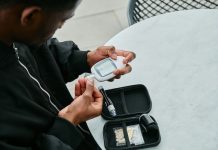
Type 2 diabetes, the most common form of diabetes, usually occurs in middle-aged and older people. However, onset at a younger age is becoming more common globally.
Retinopathy is a common complication of diabetes in which damage to the blood vessels of the retina can lead to blindness.
In a study from the University of Oslo, scientists found that men who are diagnosed with type 2 diabetes at a young age are more likely to develop retinopathy than those diagnosed aged 50-plus.
Men diagnosed with type 2 diabetes before the age of 40 were 72% more likely to have retinopathy than males who had type 2 diabetes for the same amount of time but were diagnosed at the more typical age of 50 or over.
In the study, researchers analysed data from the GP records of 10,242 people with type 2 diabetes.
The dataset was representative for Norway and the average age of diagnosis with type 2 diabetes among all the participants was 56.
A total of 980 (10.2%) had young-onset diabetes (diagnosis under the age of 40) and their average age of diagnosis was 33 years old.
This group had type 2 diabetes for 11.4 years, on average, at the time of the study, and was 55.6% male. 15.5% had retinopathy.
Their risk of retinopathy and coronary heart disease, another complication of type 2 diabetes, was compared with a group of 6,627 people who were diagnosed with type 2 diabetes aged 50-plus (normal onset type 2 diabetes).
Those diagnosed before the age of 40 had, on average, a higher HbA1c (average blood sugar level) at diagnosis than those diagnosed after 50.
In those with young-onset type 2 diabetes, HbA1c levels were higher already from the point of diabetes diagnosis but also increased more rapidly with time.
In other words, if two people had type 2 diabetes for the same length of time, HbA1c levels would likely be higher in the one diagnosed at a younger age.
The risk of coronary heart disease was more strongly linked to age in both groups than to diabetes duration.
The risk of retinopathy, however, increased with diabetes duration, with the risk increasing particularly sharply in those with young-onset type 2 diabetes.
Men with young-onset diabetes were 72% more likely to have retinopathy than those with normal-onset type 2 diabetes.
In contrast to men with young-onset type 2 diabetes, women with young-onset type 2 diabetes weren’t at significantly higher risk of retinopathy than those with normal-onset type 2 diabetes.
The analysis also showed that retinopathy developed sooner after diagnosis in men, but not women, with young-onset type 2 diabetes than in normal-onset type 2 diabetes.
The researchers say that diagnosis may be more likely to be delayed in males, who tend to visit their GP less often than females. This would mean their type 2 diabetes was uncontrolled for longer, raising their risk of complications.
If you care about eye health, please read studies about how aging eyes see as time goes by, and what you need to know diabetic eye disease.
For more information about diabetes, please see recent studies that blueberries strongly benefit people with metabolic syndrome, and results showing vitamin D could improve blood pressure in people with diabetes.
The study was conducted by Dr. Katrina Tibballs et al and presented at the Annual Meeting of the European Association for the Study of Diabetes.
Copyright © 2022 Knowridge Science Report. All rights reserved.



